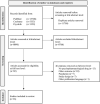Psychiatric medication and physical performance parameters - Are there implications for treatment?
- PMID: 36147967
- PMCID: PMC9488519
- DOI: 10.3389/fpsyt.2022.985983
Psychiatric medication and physical performance parameters - Are there implications for treatment?
Abstract
Introduction: The impact of psychiatric medications and their enhancing or impairing effects on physical performance remains inconclusive. Therefore, with this systematic review we provide a comprehensive overview of frequently used psychotropic drugs and their effects on physical performance for the purpose of providing empirical information and deriving prescription and therapy recommendations for clinical practice.
Methods: We systematically searched PubMed, PsycInfo, and Cochrane databases and extracted human studies investigating the effect of psychotropic drugs on parameters associated with the level of physical performance, such as exercise time, oxygen consumption, heart rate, muscle contraction or blood lactate concentration in physically healthy participants. 36 studies - comprising a broad range of psychotropic agents, such as antidepressants, antipsychotics, sedatives, and stimulants - were selected for final analyses.
Results: Most studies (N = 32) were randomized controlled trials (RCT) with a double-blind crossover design. Antidepressants (N = 21) were the most frequently studied drug class, with contradictory results e.g., performance enhancement in warm environment but not in temperate conditions for bupropion or inconsistent findings between studies for other antidepressants. Antipsychotics (N = 3) mainly showed impairing effects on physical performance, while stimulants (N = 4) were often performance-enhancing. Sedatives (N = 9) may cause a hangover effect.
Conclusion: The examined studies with heterogeneous design showed different effects of psychiatric medications on physical performance. Antipsychotics seemed to be performance impairing, while the findings for antidepressants and sedatives were more inconsistent. Stimulants were the only group with consistent performance-enhancing effects. However, most studies were conducted with a small sample size (N < 10), mostly in well-trained subjects rather than in patients with psychiatric disorders, and most studies used single-dose designs. These issues impede the formulation of generalized conclusions for treatment regimes and should therefore be considered in further longitudinal studies for clinically reliable statements. Nevertheless, answering our research question is quite relevant for clinical practice and therapeutic prescription and should be further investigated especially considering the high drop-out rates in drug treatment.
Systematic review registration: [https://www.crd.york.ac.uk/prospero/display_record.php?RecordID=276103], identifier [CRD42021276103].
Keywords: athletic performance; exercise; fitness; physical performance; psychiatric medication; psychotropic drugs; sport; systematic review.
Copyright © 2022 Hirschbeck, Leao, Wagner, Hasan and Roeh.
Conflict of interest statement
Within the last 5 years, AlH has received paid speakerships from Janssen, Otsuka, Recordati, and Lundbeck. He was member of Rovi, Recordati, Otsuka, Lundbeck, and Janssen advisory boards. He is the editor of the German AWMF S3 and the WFSBP schizophrenia guidelines. The remaining authors declare that the research was conducted in the absence of any commercial or financial relationships that could be construed as a potential conflict of interest.
Figures
References
-
- Johnston A, McAllister-Williams RH. Psychotropic drug prescribing. In: Currie A, Owen B. editors. Sports Psychiatry (Oxford Psychiatry Library). (Oxford: Oxford University Press; ) (2016). p. 133–43. 10.1093/med/9780198734628.003.0010 - DOI
-
- Stubbs B, Vancampfort D, Hallgren M, Firth J, Veronese N, Solmi M, et al. EPA guidance on physical activity as a treatment for severe mental illness: a meta-review of the evidence and position statement from the European psychiatric association (EPA), supported by the international organization of physical therapists in mental health (IOPTMH). Eur Psychiatry. (2018) 54:124–44. 10.1016/j.eurpsy.2018.07.004 - DOI - PubMed
-
- Kahl KG, Kerling A, Tegtbur U, Gützlaff E, Herrmann J, Borchert L, et al. Effects of additional exercise training on epicardial, intra-abdominal and subcutaneous adipose tissue in major depressive disorder: a randomized pilot study. J Affect Disord. (2016) 192:91–7. 10.1016/j.jad.2015.12.015 - DOI - PubMed
-
- Davis JM, Bailey SP, Jackson DA, Strasner AB, Morehouse SL. 438 Effects of a serotonin (5-H) agonist during prolonged exercise to fatigue in humans. Med Sci Sports Exerc. (1993) 25:78. 10.1249/00005768-199305001-00440 - DOI
Publication types
LinkOut - more resources
Full Text Sources


